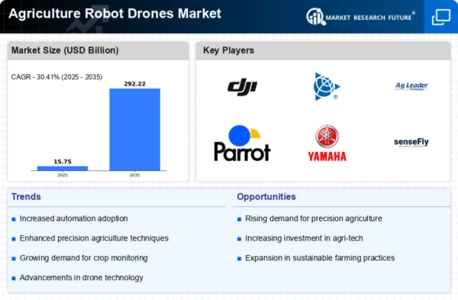Advancements in Drone Technology
Technological advancements are a key driver of the Agriculture Robot Drones Market. Innovations in drone design, battery life, and sensor technology are enhancing the capabilities of agricultural drones. For example, the development of multi-spectral and thermal imaging sensors allows for more precise monitoring of crop health and soil conditions. These advancements not only improve the accuracy of data collected but also expand the range of applications for drones in agriculture. The market for agricultural drones is expected to grow at a compound annual growth rate of 20% over the next five years, largely due to these technological improvements. As the Agriculture Robot Drones Market continues to evolve, the integration of cutting-edge technologies will likely lead to more sophisticated and efficient drone solutions.
Government Support and Subsidies
Government initiatives play a crucial role in the growth of the Agriculture Robot Drones Market. Various countries are implementing policies and providing subsidies to encourage the adoption of drone technology in agriculture. These initiatives aim to promote sustainable farming practices and improve food security. For instance, financial incentives for farmers to invest in drone technology can significantly lower the barriers to entry. Reports suggest that government funding for agricultural technology has increased by over 30% in recent years, reflecting a commitment to innovation in the sector. This support not only fosters the growth of the Agriculture Robot Drones Market but also encourages research and development, leading to more advanced and efficient drone solutions.
Increasing Labor Shortages in Agriculture
The Agriculture Robot Drones Market is being propelled by the increasing labor shortages faced by the agricultural sector. As the workforce in agriculture diminishes, farmers are compelled to seek innovative solutions to maintain productivity. Drones offer a viable alternative, enabling farmers to perform tasks such as planting, spraying, and monitoring crops with minimal human intervention. The automation of these processes can lead to significant cost savings and efficiency gains. It is estimated that the labor shortage in agriculture could reach 1.5 million workers by 2025, further emphasizing the need for technological solutions. Consequently, the Agriculture Robot Drones Market is likely to expand as farmers adopt drones to mitigate labor challenges and enhance operational efficiency.
Rising Demand for Crop Monitoring Solutions
The Agriculture Robot Drones Market is experiencing a surge in demand for crop monitoring solutions. Farmers are increasingly seeking efficient ways to assess crop health, optimize yields, and manage resources. Drones equipped with advanced imaging technology can provide real-time data on crop conditions, enabling timely interventions. According to recent estimates, the market for agricultural drones is projected to reach USD 6 billion by 2026, driven by the need for precision agriculture. This trend indicates a shift towards data-driven farming practices, where farmers leverage drone technology to enhance productivity and sustainability. As the Agriculture Robot Drones Market evolves, the integration of artificial intelligence and machine learning into drone systems is likely to further enhance their capabilities, making them indispensable tools for modern agriculture.
Growing Awareness of Environmental Sustainability
The Agriculture Robot Drones Market is increasingly influenced by the growing awareness of environmental sustainability among farmers and consumers. There is a rising demand for sustainable farming practices that minimize environmental impact while maximizing productivity. Drones can play a pivotal role in this transition by enabling precision agriculture techniques that reduce the use of fertilizers and pesticides. By providing detailed insights into crop health, drones help farmers apply inputs more judiciously, thereby promoting eco-friendly practices. Research indicates that the adoption of precision agriculture can lead to a 20% reduction in chemical usage. This shift towards sustainability is likely to drive the Agriculture Robot Drones Market as more farmers recognize the benefits of integrating drone technology into their operations.



.webp)
.webp)
.webp)
.webp)
.webp)
.webp)








Leave a Comment